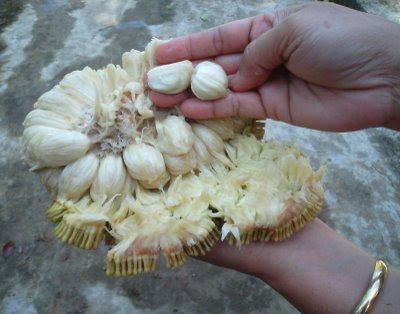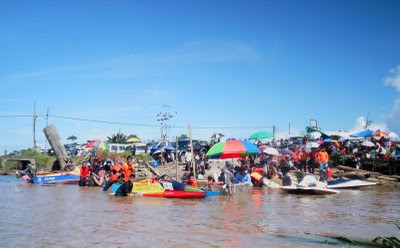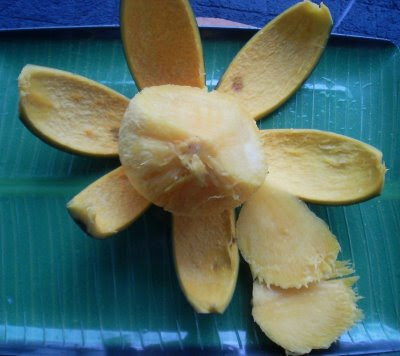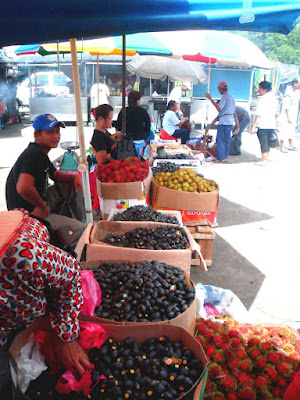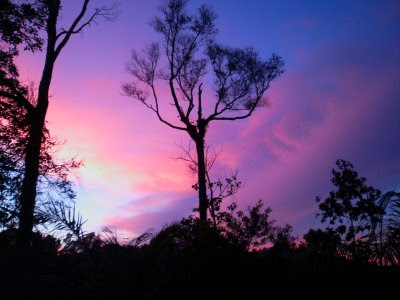
Wednesday, December 31, 2008
Morning Mist
 This is the view of the Kemena River very early in the morning, around 7.30 am with the morning mist having a light cover over the river. The small river craft to the right is called ' kapel tambang' which ferries the Kampung Jepak folks to work to the town proper everyday.
This is the view of the Kemena River very early in the morning, around 7.30 am with the morning mist having a light cover over the river. The small river craft to the right is called ' kapel tambang' which ferries the Kampung Jepak folks to work to the town proper everyday.An adult is charged RM.50 per crossing. Ahead of the 'kapel tambang' is a small ferry that carries the kampung folks who ride motorycles to work. This morning the river is at low tide.
 On the way out of my farm the other day, I was met by a heavy cover of morning mist though the time was about 7.00 am. The above view is taken before reaching the Kemena Bridge.
On the way out of my farm the other day, I was met by a heavy cover of morning mist though the time was about 7.00 am. The above view is taken before reaching the Kemena Bridge.
Labels:
Kemena River transportation,
River scenes,
Weather
Bamboo for cooking vessel

The kind of food that is stuffed inside these young bamboo stems are like glutinous rice, chicken meat or fish. At the Bintulu tamu yesterday I saw them being sold at RM 1 a piece.
In the hot and humid tropical rainforest of Bintulu , bamboos are a very important forest resource. The ways of using bamboo are very much left to imagination. Bamboos are used to build all parts of a house except the roof, where thatched palm leaves are the preference. There are made into suspension bridges, scaffoldings to reach dizzly heights to harvest bird's nest on the ceiling of caves, river rafts, furniture, handicrafts ( e.g. coin box,baskets,table mats,chopsticks, walking sticks, etc) and young bamboo buds are eaten as vegetables, so called ' bamboo shoots'. Bamboos are the tallest of all grasses, reaching 30 meters and more. And as seen in Chinese movies you can jump and run on top of bamboo trees to execute your kung fu kicks:)))
Sunday, December 28, 2008
Edible Seeds of the 'Cempedak'
 I had a fun time climbing the 'cempedak' tree today. The 'cempedak' fruit( artocarpus integer) is very much akin to the jackfruit( artocarpus heterophyllus). There are at least 5 trees that are fruiting profusely at my farm currently. The cempedak fruit is consumed in three main ways. In the above picture, its yellowish flesh which has a soft, custard-like texture can be eaten fresh. It can also be boiled with coconut milk and sugar to make 'dodol'. On the right of the picture, the seeds of the cempedak have been boiled and are ready to be eaten, preferably with honey. In Sarawak and therefore Bintulu for that matter, the fruiting season for cempedak is between the months of November right till February every year.
I had a fun time climbing the 'cempedak' tree today. The 'cempedak' fruit( artocarpus integer) is very much akin to the jackfruit( artocarpus heterophyllus). There are at least 5 trees that are fruiting profusely at my farm currently. The cempedak fruit is consumed in three main ways. In the above picture, its yellowish flesh which has a soft, custard-like texture can be eaten fresh. It can also be boiled with coconut milk and sugar to make 'dodol'. On the right of the picture, the seeds of the cempedak have been boiled and are ready to be eaten, preferably with honey. In Sarawak and therefore Bintulu for that matter, the fruiting season for cempedak is between the months of November right till February every year.Silhouettes in Sunset
Friday, December 26, 2008
A Typical December
 This year December is without doubt the wettest month of Bintulu. As I face the closing days of the year here I would like to post this picture of a view from my computer table of a typical December day. Sitting behind this huge window, I blog and get in touch with the wide wide world. Well, staying in a farm has its merits. The evergreen wash of colours over the fields is kind to the eyes.The abundance of oxygen that exudes the daily air from the tons of leaves are nature's gift to a healthy lung. The multitudes of wildlife become my companion and give much moral support to the projects that get stranded due to the heavy rains. We cannot push nature to the extremes and living in my eco-farm is like learning to live in harmony with nature. The song of the birds delights my senses as much as my spirit. The presence of wildlife jolts my soul to nature's joy of living. And the quietness of night gives me comfort after the bustle of daylight . Another day to celebrate with the rise of dawn.
This year December is without doubt the wettest month of Bintulu. As I face the closing days of the year here I would like to post this picture of a view from my computer table of a typical December day. Sitting behind this huge window, I blog and get in touch with the wide wide world. Well, staying in a farm has its merits. The evergreen wash of colours over the fields is kind to the eyes.The abundance of oxygen that exudes the daily air from the tons of leaves are nature's gift to a healthy lung. The multitudes of wildlife become my companion and give much moral support to the projects that get stranded due to the heavy rains. We cannot push nature to the extremes and living in my eco-farm is like learning to live in harmony with nature. The song of the birds delights my senses as much as my spirit. The presence of wildlife jolts my soul to nature's joy of living. And the quietness of night gives me comfort after the bustle of daylight . Another day to celebrate with the rise of dawn.Thursday, December 25, 2008
Speed boats by Bintulu's river
 Just the other day while passing the Kampung Baru village, I saw these twin-powered 200 horsepower speed boats moored by the Sebiew river,Bintulu. These boats are normally used to go offshore by timber merchants or traders to inspect their logs before loading into foreign timber ships that are anchored about 10 - 15 km off Bintulu coast. They are also rented by tourists and deep sea fishing enthusiasts to offshore fishing spots some 75-100 km away to sea. Tourists use them to cruise the Bintulu coastline or to upriver for outboard riding.
Just the other day while passing the Kampung Baru village, I saw these twin-powered 200 horsepower speed boats moored by the Sebiew river,Bintulu. These boats are normally used to go offshore by timber merchants or traders to inspect their logs before loading into foreign timber ships that are anchored about 10 - 15 km off Bintulu coast. They are also rented by tourists and deep sea fishing enthusiasts to offshore fishing spots some 75-100 km away to sea. Tourists use them to cruise the Bintulu coastline or to upriver for outboard riding.Tuesday, December 16, 2008
Bintulu's Hardest Wood
 It is called the 'Belian' ( Eusideroxylon zwageri ) .The locals here have no doubts to its longevity and resistance to insects attack or rot. Pressed further they will say that their lives revolve around it. Belian timber are made into roofing tiles or shingles, floors, jetties, house posts, fences, steps and stairs, walkways, pestles and mortars, weapons, canoe hulls, telephone and electricity posts, stakes for pepper vines or piles for civil construction. It is so useful to the peoples of Sarawak that it is prohibitted to be exported. At this sawmill ,you can buy or order to size the timber from as thick as 30 cm to as thin as 4mm, normally the size used for roofing shingles. The belian timber is heavy and therefore will sink when placed in water or river. But when submerged for say half a century or more like the ones used as posts for village houses along Bintulu river, they are not subjected to rot. Strange but true.
It is called the 'Belian' ( Eusideroxylon zwageri ) .The locals here have no doubts to its longevity and resistance to insects attack or rot. Pressed further they will say that their lives revolve around it. Belian timber are made into roofing tiles or shingles, floors, jetties, house posts, fences, steps and stairs, walkways, pestles and mortars, weapons, canoe hulls, telephone and electricity posts, stakes for pepper vines or piles for civil construction. It is so useful to the peoples of Sarawak that it is prohibitted to be exported. At this sawmill ,you can buy or order to size the timber from as thick as 30 cm to as thin as 4mm, normally the size used for roofing shingles. The belian timber is heavy and therefore will sink when placed in water or river. But when submerged for say half a century or more like the ones used as posts for village houses along Bintulu river, they are not subjected to rot. Strange but true.First Facts of Bintulu - First Garden Gazebo
This is the best picture I have of the first garden structure built at a public space and for public amenity in Bintulu in the very early years of the 1960's. The structure was probably built in 1960. The roof was made of tiles and post of belian hardwood. The floor was tiled with mosaic . This public amenity was well frequented in those days and around it were other public amenities like the see-saw and swing. The garden lawn was planted with cow grass ( axonopus compressus) and the most interesting feature was that it was planted with trees. One particular tree that still remains to this day is the yellow flame tree ( Peltophorum pterocarpum) ( Please see picture below) which is fortunately preserved in the re-making of the park and its surrounding area which is underway now.
To the left of the yellow flame tree was a swing, which I used to play with and towards the right would be the public structure or gazebo. In 1961, I was 10 years old. Thus this tree is more than 45 years old now.
The center of attraction of the park today is this fountain. However, there are no rest or garden shelter built like it used to be before.
Farm road wet as a river
The above scene is typical of Bintulu these days. Since my arrival here last Friday, it has been raining everyday, if not in the day it will surely rain at night. This morning while on the way out to fetch my worker I was met with heavy downpour that made the earth road slippery and negotiating up the steep hilly slope a tricky adventure. But I managed only because I used a 4x4 vehicle.
For Sarawak, the months of November to January are referred to as the 'Landas' season or the rainy monsoon season. The term monsoon was made popular by Arab traders who found that two monsoons a year come to tropical Asia bringing in solid downpour of rain in different places at different times. In Arabic 'musim' means season. For example the North Easterly winds that blow through the months of November till January will result in torrentious rain for Sarawak, Borneo, Sumatra and Java. While the South westerly winds will wet the areas of India, Thailand and the western parts of Peninsular Malaysia.
Saturday, November 29, 2008
Strictly No Durian
Driving Through Heavy Rains
While nearing Bintulu town on our journey back after an overnight trip from Miri, we drove into heavy rains for about two hours. Below are pictures of our car driving through the thin and thick of a heavy downpour. November's weather is of the extremes. Dry and hot one day and the next day the rains may pour endlessy.
Wednesday, November 26, 2008
Feather-leaved Palm Living in Water
From the feathered-leaved palm tree and the conical roofs across is a distance of about 300 meters.
I clicked this shot today as I was sending my worker back to his village from work at my farm.
The two yellow boats on the left are deep sea trawlers and on the right are smaller coastal fishing boats.
This river is called the Kemena River and as a small boy I used to row a tiny boat to reach this side of the river ( foreground) with my brothers to collect firewood from the sawmill which were all free for the taking. Our family used to live on the Bintulu town proper side of the river (where the conical roofs are) in the 60's-70's.
The conical roofs take the shape of our local 'Terendak' , a working hat used by Melanau men and woman for shade against the sun and rain. The blue conical roofs are the wet and dry markets, whereas the green one in the far background ( towards the left) is the 'Tamu' or jungle produce market.
The peculiar palm tree in the foreground is our kind of riverside tree. It grows submerged in water. Called the 'Nipah' in our local Melanau dialect, it grows abundantly along both sides of the Kemena River for kilometers up river where the brackish water at high tide is saline and at low tide fresh. Often people refer to it as the Mangrove Palm because it is prevalent in mangrove salty marshes or tidal mudflat areas.
A CU View of the Nipah Palm ( Nypa fruiticans)
Tuesday, November 25, 2008
A Candid Camera Shot
 A candid shot indeed. The motorcylist rides a motobike without helmet. While driving does sms. And on all counts serious for the fact that the motorbike he's driving has a 'P' plate meant for learners who should avoid doing any traffic offences. In reality however I was trying to click on the tall tree called the 'Malay Apple ' tree or 'Jambu Bol' tree ( Syzygium malaccense ) that stood tall by the road. This tree is also referred to as the 'mountain apple ' in Hawaii or in their local tonque as 'Ohia'.
A candid shot indeed. The motorcylist rides a motobike without helmet. While driving does sms. And on all counts serious for the fact that the motorbike he's driving has a 'P' plate meant for learners who should avoid doing any traffic offences. In reality however I was trying to click on the tall tree called the 'Malay Apple ' tree or 'Jambu Bol' tree ( Syzygium malaccense ) that stood tall by the road. This tree is also referred to as the 'mountain apple ' in Hawaii or in their local tonque as 'Ohia'.
Labels:
Jambu Bol,
Malay apple tree,
Syzygium malaccense
Monday, November 24, 2008
Deep Sea Trawler
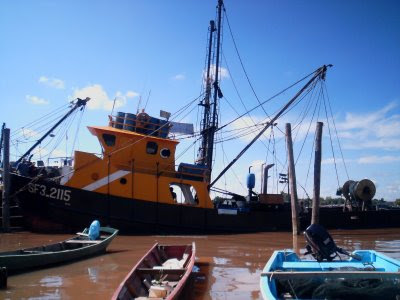 I saw this deep sea trawler unloading its catch this morning at the Bintulu fishing wharf on the river bank of Bintulu town center. For generations Bintulu was known as a fishing village and the local Bintulu fishermen are almost all Melanaus. However with the coming of the deep sea trawlers the ship's crew are mainly people employed from outside Bintulu because the local Melanau fishermen prefer to go out to sea in their own traditional small fishing vessels like their forefathers before them. Deep sea trawlers appeared in the Bintulu fishing scene around fifteen years ago.
I saw this deep sea trawler unloading its catch this morning at the Bintulu fishing wharf on the river bank of Bintulu town center. For generations Bintulu was known as a fishing village and the local Bintulu fishermen are almost all Melanaus. However with the coming of the deep sea trawlers the ship's crew are mainly people employed from outside Bintulu because the local Melanau fishermen prefer to go out to sea in their own traditional small fishing vessels like their forefathers before them. Deep sea trawlers appeared in the Bintulu fishing scene around fifteen years ago.Sunday, November 23, 2008
The delicious Terap fruit ( artocarpus odoratissimus Blanco)
It is called 'Terap' in Malay or 'Ong Lumok' in the local Melanau dialect. The flesh or aril is succulent, very sweet and has tiny seeds the size of groundnuts which can be roasted or fried as snacks for afternoon tea. Since last month and through to December this fruit are easily seen at the local jungle produce market in Bintulu. A fruit of the above size will normaly sell for RM 3. The skin has short,blunt and soft thorn-like covering but not pricky.
The 'terap' fruit tree is indeed tall, can reach 20 m high. Therefore to collect the fruit one has to climb the tree and pluck them from their end branches being cautious not to let them drop as once dropped the soft skin will be smashed and the fruits squashed and littered. The climbers will pluck semi ripe fruits and keep them for a day or two for ripening before they bring them to market.The leaves of the terap are large, about 30 - 40 cm long and 20-25 cm wide.
There are many varieties of the terap fruit with arils in colours of red and yellow.
Here's another variety with covering looking like rough hairs so is called 'Terap Bulu' ( artocarpus sericarpus)to mean hairy 'terap'.
The terap fruit comes from the same family as the breadfruit ( artocarpus communis Forst or its synonym: A.altilis) and is considered a staple fruit among the Pacific Islanders and many areas of South East Asia.
Saturday, November 22, 2008
School's Out
This week the school term ended on the 15th of November and schools throughout Malaysia are now having the long end of year holiday . Already kids are frolicking in the mud playing football . As I watched them play in the late afternoon sun I remembered my days when I was a kid just like them too.
They reminded me now - Have Fun with Life.
Monday, November 17, 2008
Wild Durians of Bintulu and the Durian Theory
People who are familiar with Borneo knows very well the cultivated variety of durians ( Durio zibethinus) or ' King of the Fruits ' as what they are fondly called in this part of the world. It is according to some theorists a very primitive fruit in the evolutionary ladder of our present fruit tree because of its strong armour, height , colour and smell it has been able to win over competition among other trees in the tropical forest environment and survived to the present day. Seriously, this theory is called the Durian Theory.
The cultivated durian fruit is notorius for its intense smell, offensive for some but a welcome fragrance to many who will part any amount of money to buy one good fruit. Meaning RM 30 for a perfect fruit!
But among hoteliers its a NO, NO fruit to be allowed into the hotel premise. Thus it is no surprise that notices like these appear on hotel lifts:
" NO Durians or Outside Guests of Opposite Sex Allowed "
Durio oxleyanus Griff.
Among the Ibans the wild durian fruit above is called 'Isu'. Slightly harder to open, it has sharp and long thick thorns. However is much priced due to its aroma and sweet ' heavenly taste' to many jungle inhabitants and dwellers of the rainforest of Borneo.
This fruit appears to come in season right now to make up for the disappearing cultivated durians species which are in its tail end of the fruiting season. It's a little hefty on the price tag because its sold now by the kilo, which is RM 15/kilo.
Durio kutejensis
The local Ibans in Sarawak call the above fruit 'Nyekak'. The Malays call them 'durian kuning '( yellow durian) on account of its yellowish colour flesh or pulp.
In this species, the thorns are short, skin and flesh yellow and are easily opened by applying a slight pressure of both hands on the fruit. It has brown seeds, much smaller than the cultivated species and in many cases have tiny or no seeds at all. Tastes sweet and does not give the hiccups if you take too many like the durians. A small size fruit like above weighs half a kilo and at present price in Bintulu is RM 5 per fruit.
Sunday, November 16, 2008
Kuala Tatau Water Festival
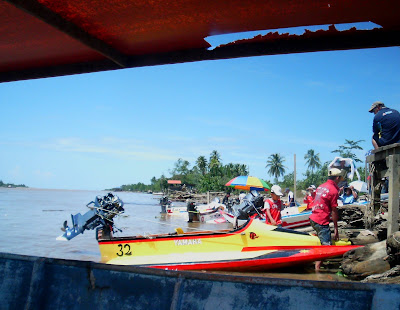 The Kuala Tatau village was a buzz today, roaring to the powerful outboard engines like the ones above as part of this year '45 Years of Sarawak's Independence Through Malaysia ' celebration.
The Kuala Tatau village was a buzz today, roaring to the powerful outboard engines like the ones above as part of this year '45 Years of Sarawak's Independence Through Malaysia ' celebration. A fishing boat decorated with the Malaysian flags greet spectators as they walked up the ramp after disembarking the small boat that ferry them to reach the main village across. Rates: Adults = RM 1.50 per person. Children = Free.
A fishing boat decorated with the Malaysian flags greet spectators as they walked up the ramp after disembarking the small boat that ferry them to reach the main village across. Rates: Adults = RM 1.50 per person. Children = Free. Wednesday, November 12, 2008
Strong winds and choppy waters in Bintulu today
The first sign that a sudden change in weather was imminent was when I saw these grasses bending low at the Bintulu Waterfront Promenade.
Very quickly strong winds slammed the palm trees, sending visitors scurring for cover. Suddenly there was not a soul taking a stroll at the promende.
Going further up to Kidurong Housing Beach area some 20 minutes drive from the mouth of the Kemena River ( where sits the promenade) I saw many small fishing crafts moored at the lagoon area seeking safety from the choppy waters offshore and impending stormy weather. This is typical of the end of year weather at Bintulu ( Nov- Dec) when strong winds can send waves up to three or four meters high making the sea most dangerous for small fishing crafts like these.
Friday, November 7, 2008
Bintulu expecting Chinese tourists?
This is the main street when you drive into Bintulu town proper. However the signboard seen today is not the norm. Is Bintulu expecting Chinese tourists? In the Parliament session yesterday, the Tourism Ministry encouraged the use of mutli-language signboards in certain locations. For example in Kuala Lumpur, where there are hundreds of thousands of Middle East tourists coming yearly, the use of Arabic in the signboards will help the tourists to find their way around KL. By the same virtue, is Bintulu expecting more Chinese tourists soon?
Thursday, November 6, 2008
Seasonal Fruits - Rambutan ( Nephelium lappaceum)
Today is a day within the rambutan fruiting season. When I went to Bintulu town, there were red and yellow rambutans by the baskets and van loads. From November to February every year, the rambutans without fail show themselves on trees. 'Rambut ' in Malay means hairs and the name rambutan refers to the mass of hairs ( .5-2cm) stuck on the skin of the rambutan fruit. The rambutans are oval in shape and in some varieties the oval shaped could be slightly enlongated. The unripe fruit is green and sour. When ripe the rambutans' flesh or pulp are very sweet especially the hybrid ones. To eat the ripe rambutan, remove the skin by a slight twisting movement of hand, then bite into the flesh or pulp and soon the fleshy pulp is peeled off from the seed.
In Borneo there are at least 25 species of the rambutans. The trees flower up to 300 ft above sea level. Thus on higher altitudes rambutan don't bear fruit. Rambutans , like the 'mata kuching', 'lici' and 'pulasan' belongs to the genus nephelium. In Greek 'nephelion' means 'little cloud' refering to the delicious pulp surrounding the seeds of these fruits. The peeled flesh are now canned and in some cases are mixed with pineapples for added appeal and taste. By the way in one sitting you can eat as many rambutans as you can.
In Borneo there are at least 25 species of the rambutans. The trees flower up to 300 ft above sea level. Thus on higher altitudes rambutan don't bear fruit. Rambutans , like the 'mata kuching', 'lici' and 'pulasan' belongs to the genus nephelium. In Greek 'nephelion' means 'little cloud' refering to the delicious pulp surrounding the seeds of these fruits. The peeled flesh are now canned and in some cases are mixed with pineapples for added appeal and taste. By the way in one sitting you can eat as many rambutans as you can.
Fresh tuna at Bintulu's market
One one my favourites routine when in Bintulu town is to drop by at the fish market situated at Kampung Baru ,tugged by the lazy the Sebiew River. At this market you can get fresh tuna very easily because Bintulu is rich in deepwater fishing grounds. Trawlers and small fishing boats are plenty in Bintulu, a town once known only as a fishing town but now a showpiece of industrial progress.
The fish monger today has sliced the tuna into slim pieces and a plate of the above costs me RM 8, weighing slightly more than a kilo . Today the going rate is RM 6/kilo. I like to fry tuna though it can be barbequed, grilled or prepared in curry or soya sauce.
By the way the local Bintulu Melanaus are great fish eaters and as they say fish is good for the heart. They live longer here. They even eat fish raw in the form of 'umai' . If you happen to be in Bintulu and never tried 'umai', you would have miss the real Bintulu.
Tuesday, November 4, 2008
Bintulu town fountain
 This town fountain in Bintulu takes the shape of the 'terendak' , a Malay traditional hat or 'saong' in local Melanau dialect. However it is built entirely of stainless steel. The same shape is also used for the town's market roof structure in the background. It is increasingly becoming an icon for Bintulu especially amongst out-of-towners and tourists.
This town fountain in Bintulu takes the shape of the 'terendak' , a Malay traditional hat or 'saong' in local Melanau dialect. However it is built entirely of stainless steel. The same shape is also used for the town's market roof structure in the background. It is increasingly becoming an icon for Bintulu especially amongst out-of-towners and tourists.Wild banana ( M. hirta) lilac spikes
 As an ornamental plant favourite this wild banana plant called 'pisang lengki' ( M. hirta) by the Ibans is an ideal plant for landscaping because they are relatively short, grow in small clump and produces brilliant lilac bracts and light orange inflorescence.
As an ornamental plant favourite this wild banana plant called 'pisang lengki' ( M. hirta) by the Ibans is an ideal plant for landscaping because they are relatively short, grow in small clump and produces brilliant lilac bracts and light orange inflorescence. The leaves of this plant as well as its soft stem ( inner core) can be cooked as vegetables. The terminal spike which contain male flowers and are closed towards the remaining end ( called the 'jantung' in Malay) can be cooked with coconut milk or grilled and eaten as salad, preferably with the famous Bintulu shrimp paste, the belacan.
The leaves of this plant as well as its soft stem ( inner core) can be cooked as vegetables. The terminal spike which contain male flowers and are closed towards the remaining end ( called the 'jantung' in Malay) can be cooked with coconut milk or grilled and eaten as salad, preferably with the famous Bintulu shrimp paste, the belacan.At the very early stage of flowering, the wild banana flower spike squeezes itself out from the tip of the banana stem showing its beautiful bracts. I hope in later postings I can show more pictures of this plant as it produces more flowers and finally fruits.
Seasonal fruits - Ong Balem ( Mangifera pajang)
'Ong Balem' are what the local Melanaus here name the seasonal fruit which look like canon balls in the picture above. They have a thick skin but are easily removed from the flesh as in the next picture below. The Ibans refer to them as 'bambangan'. They are found wild though many are nowadays cultivated in rural orchards. These fruits can weigh between 1-2 kilos and can reach 10 - 15 cm long or 10 - 15 cm wide. Most of them are spherical. Because of this unique shape and quality ( i.e. without hairs) the Melanaus would jokingly refer to a bald headed person's head as 'ong balem'.
The thick yellow flesh are fibrous and can be fine or rough in texture. The skin can be chopped into vegetables , eaten as salad with 'sambal belacan' or shrimp paste and pickled.
Above, the slices are ready to be eaten raw. Depending on the variety the flesh can taste extremely sweet or sour sweet. Because the skin is thick, the fruits once harvested can have a long shelf life averaging about two weeks. After peeling all the yellow flesh away, what is left is a big seed which tastes bitter and seldom eaten.
Monday, November 3, 2008
Seasonal fruits - Dabai (canarium odontophyllum)
It is the moment of seasonal fruits in Bintulu. Towards the end of every year, all kinds of seasonal fruits will be seen in the market place. Two kinds of fruits shown above are the rambutans ( red and yellow varieties) and the black fruit is called the dabai.
The dabai is sometimes called the tropical olive or Sibu olive. Sibu being a town in Sarawak where they are found in abundance .
Dabai fruits in baskets
Going to town today, I dropped by at the Tamu ( jungle produce market) to buy a kilo of these rare fruits. A kilo of dabai, depending on their varieties, tastes and sizes fetch around RM 6 - 15 a kilo in peak season.How do you eat the dabai? First dip them inside a bowl of warm water for 15-20 minutes. Then add salt or soya bean sauce for flavour. The fruit tastes buttery and has a yellowish soft texture. Size is about 3-4 cm long, 2 cm wide. The trees can reach about 20 m high and initially the unripe fruits appear white in colour and changes to red and finally black in its successive ripening stages. The black skin is eaten together with the flesh but not the seed which is very hard. Here people eat the dabai with their rice.
A dabai tree by the roadside at Kampung Jepak, Bintulu. Note the unripe white fruits at the tip of the branches.
Subscribe to:
Posts (Atom)














